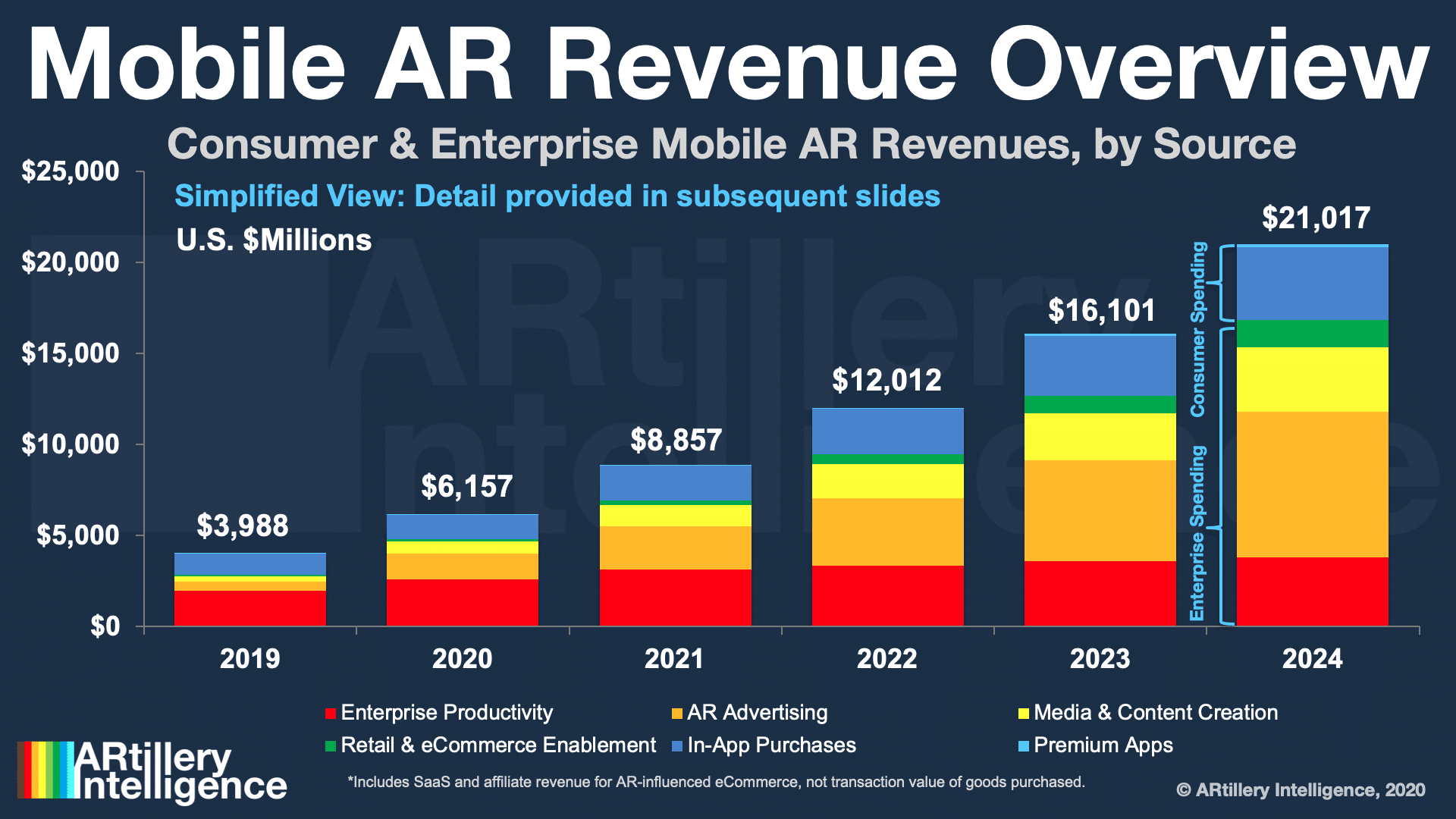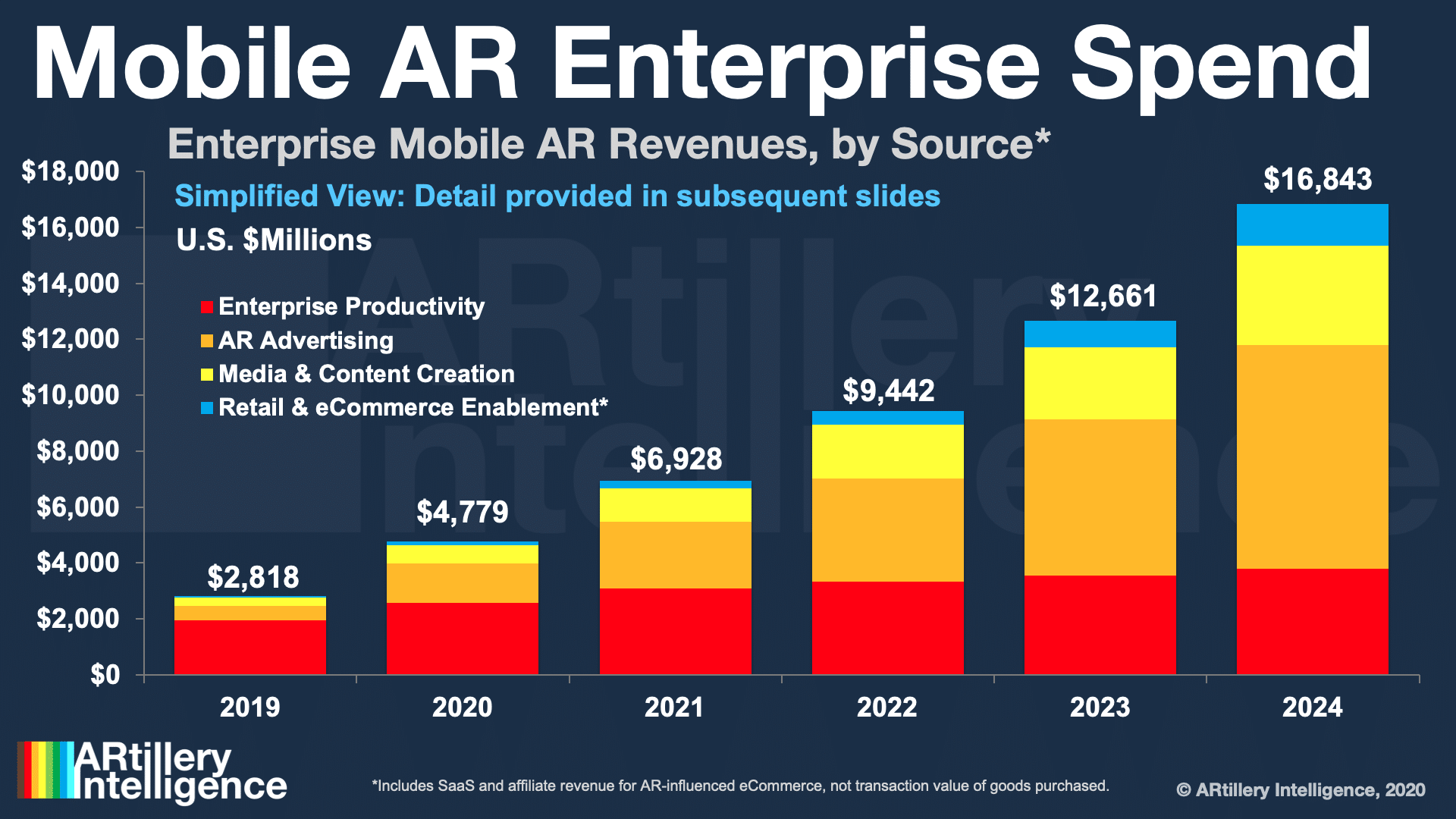
![]() ARtillery Briefs is a video series that offers insights in under 5 minutes. Each episode summarizes strategic takeaways from ARtillery’s original reports and market forecasts. See below narrative takeaways and embedded video. For the full library, subscribe to ARtillery PRO.
ARtillery Briefs is a video series that offers insights in under 5 minutes. Each episode summarizes strategic takeaways from ARtillery’s original reports and market forecasts. See below narrative takeaways and embedded video. For the full library, subscribe to ARtillery PRO.
Augmented Reality continues to be challenged in gaining traction…but there are a few bright spots. Specifically, revenue continues to gain momentum in select mobile AR categories. The advantage there of course is a built-in hardware installed base.
One of the challenges however — beyond slow cultural adoption — is that AR isn’t a silver bullet (contrary to circa-2017 sentiments). But it does excel in certain areas, which so far include brand advertising, consumer shopping and enterprise productivity.
So to quantify those areas today and projected forward, AR Insider’s research arm ARtillery Intelligence did a deep dive on smartphone-based AR in its latest revenue forecast. This is also the topic of the latest episode of ARtillery Briefs, with takeaways and video below.
AR-Ready
So what did the report uncover? At a high level, Global mobile AR revenue is projected to grow from $3.98 billion last year to just over $21 billion in 2024. This consists of consumer and enterprise spending, which are further subdivided into hardware and software.
One driving factor driving is the smartphone installed base, as noted. There are almost 3.5 billion global smartphones, an increasing share of which are AR-enabled. That total is fragmented into several platforms, versus the simple ARkit calculation of a few years ago.
When adding up and de-duplicating AR-active devices, we get 598 million projected by the end of 2020. Share on XThese platforms include Facebook’s Spark AR, Snapchat’s Lens Studio, ARkit, ARCore, Web AR and wild-card emerging platforms like TikTok. These have varying installed bases, the greatest of which today is Web AR, with about 3 billion compatible devices globally.
But the figure that matters more than AR-ready devices is those that are AR-active. When adding those up and de-duplicating them (adjusting for overlapping use between platforms), we get 598 million. That’s the projected total of AR-active devices by the end of this year.

Zeroing In
Zeroing in on revenue, consumer AR software spending will grow from almost $1.2 billion last year to almost $4 billion by 2024. This is dominated by in-app purchases, which are in turn dominated by player spending in Pokémon Go which reached almost $900 million last year.
Consumer spending on AR-influenced physical goods — a.k.a. “try before you buy” product visualization meanwhile reached $721 million in 2019. This is the transaction value of goods purchased using AR, which is tracked for perspective but isn’t counted towards AR revenue.
Google Swirl could serve as an important AR accelerant by incentivizing brand adoption through Google-scale distribution. Share on XThat exclusion is simply because it would inflate AR’s value to count the $2000 couch you bought using the IKEA Place app as “AR Revenue.” Instead, AR’s proportionate role in the value chain is counted as AR revenue, such as commerce-enablement software.
The latter includes things like 3D asset and ad experience creation, which will be a critical component of the AR Commerce value chain. For example, Google Swirl could serve as an important AR accelerant by incentivizing brand adoption through Google-scale distribution.

AR as a Service
That commerce-enablement piece falls into the broader category of enterprise mobile AR, which we project to grow from $2.8 billion last year to almost $17 billion in 2024. This includes all enterprise spending — ranging from consumer brands to industrial enterprises.
The latter in fact accounts for the leading share of mobile AR enterprise spending today. This involves AR’s use in supporting industrial and corporate productivity. It includes line-of-sight visualization in functions like maintenance, assembly and customer support.
Another key enterprise mobile AR spending category is software for media & content creation. This includes platforms like Unity that enable companies to build AR for internal purposes or for their customers. The latter is a mobile AR revenue category we call B2B2C.
AR could follow the broader enterprise software world in building SaaS-like 'AR as a Service' models. Share on XLastly, Mobile AR enterprise revenue includes advertising, which tracks brand spending to distribute AR lenses and product visualization through paid ad campaigns. This is popular today with AR lenses but will grow over time into other high-value formats like visual search.
All of the above represent opportune revenue categories as AR software providers meet demand for democratized AR creation and accelerated time to market. This could follow the broader enterprise software world in building SaaS-like “AR as a Service” models.

Covid-Era
But that all just scratches the surface: You can see more in the full report, and in the ARtillery Briefs Episode below. In closing, it should also be noted that all of the above will be influenced by Covid-era dynamics, which have an uneven impact across mobile AR sectors.
Given that digital products are faring well during global lockdowns, the impact on mobile AR will be mostly positive. We’re already seeing that in quarantine-friendly consumer AR like social lenses; and enterprise remote-AR support that aligns with social distancing.
We believe these factors will cause near-term adoption inflections. But through that Covid-driven adoption process, AR’s overall advantages could be exposed. And that could in turn support the technology’s longer-term sustained adoption as new habits are formed.





